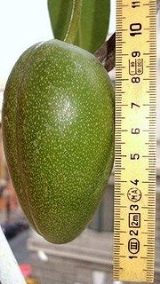
Stephanotis floribunda
Encyclopedia

In the UK they can flourish for years, grown indoors on a sunny windowsill. They can be moved outside or into a greenhouse during the summer.
Flowers
The flowers are waxy, star-shaped and highly scented, about 3cm long, in clusters and are produced in summer. Flowers fade to yellow after several days. They are a favourite in weddings, used in bridal bouquets, corsages and decorations. Normally the plant has to be a little old and root bound to start flowering. Once it does, the result is very rewarding. The flowers are long-lasting and sweetly scented.Propagation
Propagation is by cuttings or by the seeds, which are produced irregularly. Seeds are produced in a four inch pod somewhat resembling a mango. Seeds are fully mature in approximately twelve months regardless of whether or not the pod has changed color or split open. Seeds are tightly compacted in the center of the pod and can be removed in one compact bundle, each pod producing 70 to 100 flattened half inch (1.3 cm) seeds. If the seeds are left to dry out, the bundle will begin to break up and silky 'parachutes' will begin to unfurl on each seed in the same manner as the related species, the American milkweed. Seeds propagate best if sown immediately upon opening the pod. Seeds should be sown under only enough soil to keep them moist, and kept in a well lighted place until germination. Fresh seeds will germinate in about seven days. The longer the seeds remain to dry outside the pod before sowing, the longer the germination time and the lower the propagation rate.In one comparison experiment two pods were taken from the same plant growing outdoors in Houston, Texas, in July of 2009. One pod was harvested in June at 11 months of maturity and its seeds dried for one month. The other pod was harvested in July at twelve months. The seeds from both pods were planted at the same time under identical circumstances. The dried seeds took two weeks to germinate at a 60% rate as compared to near 100% germination at one week of the seeds sown within one hour of being removed from the pod. In this experiment the seeds were pushed at various angles into wet seed pots and left under a clear plastic cover in a well-lit, north-facing window at temperatures ranging from 73F to 77F (23C to 25C). The seeds have one pointed end, but the directional orientation of the point in planting did not seem to make a difference in germination.

